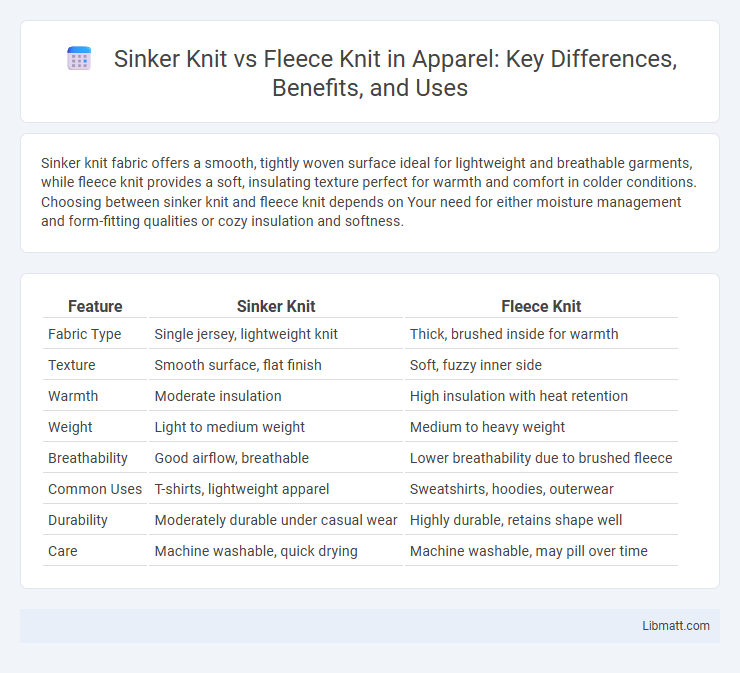Sinker knit fabric offers a smooth, tightly woven surface ideal for lightweight and breathable garments, while fleece knit provides a soft, insulating texture perfect for warmth and comfort in colder conditions. Choosing between sinker knit and fleece knit depends on Your need for either moisture management and form-fitting qualities or cozy insulation and softness.
Table of Comparison
| Feature | Sinker Knit | Fleece Knit |
|---|---|---|
| Fabric Type | Single jersey, lightweight knit | Thick, brushed inside for warmth |
| Texture | Smooth surface, flat finish | Soft, fuzzy inner side |
| Warmth | Moderate insulation | High insulation with heat retention |
| Weight | Light to medium weight | Medium to heavy weight |
| Breathability | Good airflow, breathable | Lower breathability due to brushed fleece |
| Common Uses | T-shirts, lightweight apparel | Sweatshirts, hoodies, outerwear |
| Durability | Moderately durable under casual wear | Highly durable, retains shape well |
| Care | Machine washable, quick drying | Machine washable, may pill over time |
Understanding Sinker Knit and Fleece Knit Fabrics
Sinker knit fabric features a smooth, tightly woven surface created by sinking needles, making it durable and ideal for activewear and casual garments. Fleece knit fabric is characterized by a soft, brushed texture on one side that provides warmth and comfort, commonly used in sweatshirts and cold-weather apparel. Understanding the differences helps you choose the right fabric based on breathability, insulation, and durability needs.
Key Differences Between Sinker Knit and Fleece Knit
Sinker knit features a smooth, flat surface with fine, dense stitching ideal for lightweight, breathable fabrics, while fleece knit is characterized by a soft, brushed texture that provides warmth and insulation. Sinker knit is commonly used in athletic wear for moisture wicking and durability, whereas fleece knit excels in cold-weather garments thanks to its plush, insulating properties. Understanding these key differences helps you choose the best knit fabric for your specific comfort and performance needs.
Manufacturing Process of Sinker Knit vs Fleece Knit
Sinker knit fabric is produced using a single-needle bar and sinker system on circular knitting machines, creating a smooth, flat surface ideal for lightweight, breathable textiles. Fleece knit undergoes a similar circular knitting process but is followed by additional finishing steps like brushing or napping to raise fibers, resulting in a thicker, warmer fabric with a soft, fuzzy texture. Understanding these manufacturing differences helps you select the appropriate knit for durability, warmth, or comfort.
Texture and Feel: What Sets Them Apart
Sinker knit features a smooth, lightweight texture ideal for breathable garments, while fleece knit offers a soft, plush feel providing superior warmth and insulation. The unique looped construction of fleece knit traps air, enhancing its cozy comfort, whereas sinker knit's flat surface ensures a sleek and flexible fabric. Your choice depends on whether you need moisture-wicking breathability or cozy thermal retention.
Breathability and Warmth Comparison
Sinker knit fabric offers superior breathability due to its open structure, making it ideal for activewear that requires moisture-wicking and airflow. Fleece knit, on the other hand, provides exceptional warmth with its dense, insulating fibers that trap heat effectively. Your choice depends on whether you prioritize ventilation and cooling or maximum thermal insulation for cold conditions.
Durability and Everyday Wearability
Sinker knit fabric is renowned for its exceptional durability, maintaining shape and color through prolonged use and frequent washing, making it ideal for everyday wear. Fleece knit, while softer and warmer, tends to be less resistant to pilling and abrasion, which can affect its longevity in regular use. For garments requiring robust wearability and long-term resilience, sinker knit offers superior performance compared to fleece knit.
Popular Uses for Sinker Knit and Fleece Knit
Sinker knit fabric is widely used in sportswear and activewear due to its durability, moisture-wicking properties, and ability to maintain shape during intense physical activity. Fleece knit, popular for its insulating warmth and soft texture, is commonly utilized in cold-weather garments like hoodies, sweatshirts, and jackets. When selecting fabric for your project, choose sinker knit for breathability and performance or fleece knit for comfort and thermal insulation.
Maintenance and Care Tips for Each Fabric
Sinker knit requires minimal maintenance, as its dense construction resists pilling and holds shape well, making it easy to machine wash in cold water and tumble dry on low heat without shrinking. Fleece knit demands gentler care to preserve softness and prevent matting; hand washing or using a gentle cycle in cold water with mild detergent is ideal, and air drying or low-heat tumble drying is recommended. Your choice between sinker knit and fleece knit impacts how much time you'll spend on fabric care, with sinker knit offering more durability and less intensive upkeep.
Price Points: Which Offers Better Value?
Sinker knit typically offers better value due to its lower price point and durability, making it ideal for cost-conscious buyers seeking long-lasting fabric. Fleece knit, while more expensive, provides superior warmth and softness, which can justify the higher cost for your comfort needs. When comparing price points, sinker knit's affordability contrasts with fleece's premium feel, helping you decide based on budget and fabric performance.
Choosing the Right Fabric for Your Needs
Sinker knit fabric offers a smooth, dense texture ideal for moisture-wicking and durability, making it suitable for athletic wear or active lifestyles. Fleece knit provides superior warmth and softness through its plush, brushed interior, perfect for cozy, insulating garments in colder conditions. Assess your activity level and climate to choose the fabric that best meets your comfort and performance requirements.
Sinker knit vs fleece knit Infographic

 libmatt.com
libmatt.com